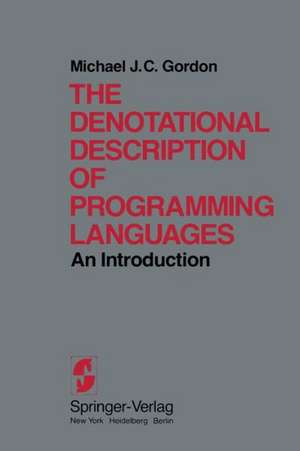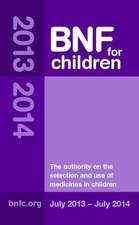The Denotational Description of Programming Languages: An Introduction
Autor M.J.C. Gordonen Limba Engleză Paperback – 19 ian 1987
Preț: 326.28 lei
Preț vechi: 407.85 lei
-20% Nou
Puncte Express: 489
Preț estimativ în valută:
62.44€ • 65.49$ • 51.97£
62.44€ • 65.49$ • 51.97£
Carte tipărită la comandă
Livrare economică 01-15 aprilie
Preluare comenzi: 021 569.72.76
Specificații
ISBN-13: 9780387904337
ISBN-10: 0387904336
Pagini: 162
Ilustrații: VI, 162 p.
Dimensiuni: 155 x 235 x 9 mm
Greutate: 0.25 kg
Ediția:1st ed. 1979. 3rd printing
Editura: Springer
Colecția Springer
Locul publicării:New York, NY, United States
ISBN-10: 0387904336
Pagini: 162
Ilustrații: VI, 162 p.
Dimensiuni: 155 x 235 x 9 mm
Greutate: 0.25 kg
Ediția:1st ed. 1979. 3rd printing
Editura: Springer
Colecția Springer
Locul publicării:New York, NY, United States
Public țintă
ResearchCuprins
1. Introduction.- 1.1. Syntax, semantics and pragmatics.- 1.2. The purposes of formal semantics.- 1.3. Denotational semantics.- 1.4. Abstract entities and their description.- 2. A first example: the language TINY.- 2.1. Informal syntax of TINY.- 2.2. Informal semantics of TINY.- 2.3. An example.- 2.4. Formal semantics of TINY.- 3. General concepts and notation.- 3.1. Abstract syntax.- 3.2. Sets and domains.- 3.3. Defining domains.- 3.4. Functions.- 4. Denotational description of TINY.- 4.1. Abstract syntax.- 4.2. Semantics.- 5. Standard semantics.- 5.1. Continuations.- 5.2. Locations, stores and environments.- 5.3. Standard domains of values.- 5.4. Blocks, declarations and scope.- 5.5. Standard domains of continuations.- 5.6. Standard semantic functions.- 5.7. Continuation transforming functions.- 5.8. Assignments and L and R values.- 5.9. Procedures and functions.- 5.10 Non standard semantics and concurrency.- 6. A second example: the language SMALL.- 6.1. Syntax of SMALL.- 6.2. Semantics of SMALL.- 6.3. A worked example.- 7. Escapes and jumps.- 7.1. Escapes.- 7.2. Jumps.- 8. Various kinds of procedures and functions.- 8.1. Procedures (or functions) with zero or more parameters.- 8.2. Recursive procedures and functions.- 8.3. Static and dynamic binding.- 8.4. Parameter passing mechanisms.- 8.5. Procedure calling mechanisms.- 8.6. Summary of calling and passing mechanisms.- 8.7. Procedure and function denoting expressions (abstractions).- 8.8. Declaration binding mechanisms.- 9. Data structures.- 9.1. References.- 9.2. Arrays.- 9.3. Records.- 9.4. Data structure valued expressions.- 9.5. Files.- 10. Iteration constructs.- 10.1. repeat C until E.- 10.2. Event loops.- 10.3. For-statements.- 11. Own-variables.- 11.1. The within construct.- 11.2. Different interpretations of ALGOL 60 own-variables.- 11.3. Semantics of own-variables.- 12. Types.- 12.1. Various kinds of types.- 12.2. Well-typed programs and type-checking.- 12.3. The semantics of types.- Appendix: Remarks for instructors and sample exercises.- Sample exercises.- References.- Subject and Author Index.- Symbols.










